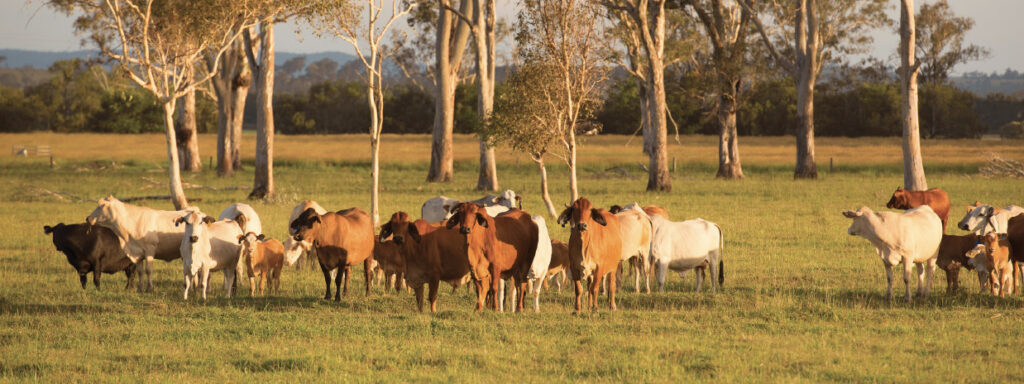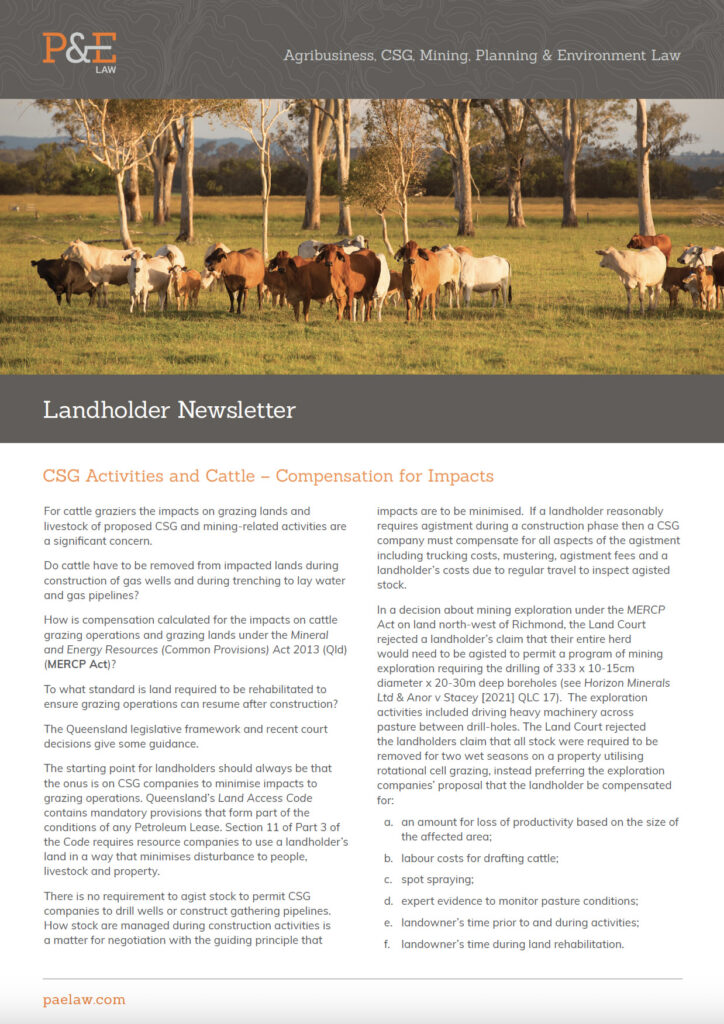
CSG Activities and Cattle – Compensation for Impacts
This edition of our Landholder Newsletter focuses on the potential for compensation for the impacts of CSG activities on grazing land and stock. It also includes a review on the state of play regarding Mining Lease Objections.
[April 2024]
For cattle graziers the impacts on grazing lands and livestock of proposed CSG and mining-related activities are a significant concern.
Do cattle have to be removed from impacted lands during construction of gas wells and during trenching to lay water and gas pipelines?
How is compensation calculated for the impacts on cattle grazing operations and grazing lands under the Mineral and Energy Resources (Common Provisions) Act 2013 (Qld) (MERCP Act)?
To what standard is land required to be rehabilitated to ensure grazing operations can resume after construction?
The Queensland legislative framework and recent court decisions give some guidance.
The starting point for landholders should always be that the onus is on CSG companies to minimise impacts to grazing operations. Queensland’s Land Access Code contains mandatory provisions that form part of the conditions of any Petroleum Lease. Section 11 of Part 3 of the Code requires resource companies to use a landholder’s land in a way that minimises disturbance to people, livestock and property.
There is no requirement to agist stock to permit CSG companies to drill wells or construct gathering pipelines. How stock are managed during construction activities is a matter for negotiation with the guiding principle that impacts are to be minimised. If a landholder reasonably requires agistment during a construction phase then a CSG company must compensate for all aspects of the agistment including trucking costs, mustering, agistment fees and a landholder’s costs due to regular travel to inspect agisted stock.
In a decision about mining exploration under the MERCP Act on land north-west of Richmond, the Land Court rejected a landholder’s claim that their entire herd would need to be agisted to permit a program of mining exploration requiring the drilling of 333 x 10-15cm diameter x 20-30m deep boreholes (see Horizon Minerals Ltd & Anor v Stacey [2021] QLC 17). The exploration activities included driving heavy machinery across pasture between drill-holes. The Land Court rejected the landholders claim that all stock were required to be removed for two wet seasons on a property utilising rotational cell grazing, instead preferring the exploration companies’ proposal that the landholder be compensated for:
- an amount for loss of productivity based on the size of the affected area;
- labour costs for drafting cattle;
- spot spraying;
- expert evidence to monitor pasture conditions;
- landowner’s time prior to and during activities;
- landowner’s time during land rehabilitation.
In another mineral exploration case, Bowen Basin Coal Pty Ltd v Namrog Investments Pty Ltd [2020] QLC 23, the Land Court considered the impacts on a cattle-grazing operation near Dysart caused by the drilling of 35 exploration core drill holes, three seismic drill holes, 12 kms of seismic line and the use of numerous kilometres of access along existing tracks.
The landholder and the exploration company engaged valuers and agronomists. It was agreed between the parties that 2 paddocks would be the most affected with 3 other paddocks having some exploration activities occurring on them. 28 of the 35 drill sites were to occur in the 2 mostly affected paddocks.
Cattle could remain in these paddocks during drilling provided the work sites were fenced off. But the court agreed that the 2 paddocks would need to be destocked during the rehabilitation phase. The agronomists disagreed on carrying capacity for the paddocks as well as other matters such as average daily weight gain.
Because the parties could not agree, the Land Court made an assessment of productivity losses and lost opportunity cost. The court held that landholder was entitled to $107,300 which included $38,237 in productivity losses and $28,813 in opportunity cost as well as additional compensation for labour costs, fencing and owner’s time.
In intense CSG developments, it is not unusual for landholders to claim the cost of agisting all stock from the affected property during the construction phase.
Under the MERCP ACT landholders are entitled to be reimbursed for the costs of engaging an agronomist to assist in the negotiation and preparation of a Conduct and Compensation Agreement for exploration or CSG development.
Mining Lease Objections Review
The Queensland Law Reform Commission (QLRC) is currently undertaking a review of the process for parties to object to the grant of Mining Leases.
The review is being overseen by the Chair of the QLRC, President Kingham. President Kingham is the former President of the Land Court and has significant experience overseeing Land Court litigation in respect of mining lease objections.
Landholders will be aware that there has been significant objection litigation in recent years including:
Waratah Coal’s Galiliee Coal Mine
This was a landmark decision in which the Land Court recommended refusal of the grant of a coal mining lease for a number of reasons including climate change impacts, impacts on a Nature Refuge and impacts on a number of human rights under the Human Rights Act 2019 (Qld).
The New Acland (Stage 3) Coal Mine
Over 30 objections were made to the grant of a mining lease. The objections were made by numerous famers for a range of reasons including impacts on groundwater, air quality, noise, and loss of agricultural land. The litigation lasted many years with appeals and counter-appeals, the lead objector being the Oakey Coal Action Alliance.
The project has since been approved by the grant of mining lease by the Queensland Government.
The QLRC will review the existing processes to decide applications for mining leases under the Mineral Resources Act 1989 (Qld) (MRA) and environmental authorities under the Environmental Protection Act 1994 (Qld). The review will also consider other matters such as the fact that production tenures for resource activities such as coal seam gas mining under petroleum leases issued under the Petroleum and Gas (Production and Safety) Act 2004 (Qld)) do not currently fall within the mining objections process.
A Consultation Paper will be published by the QLRC in July 2024 inviting submissions from members of the public. Landholders are encouraged to have input into the objections review.
